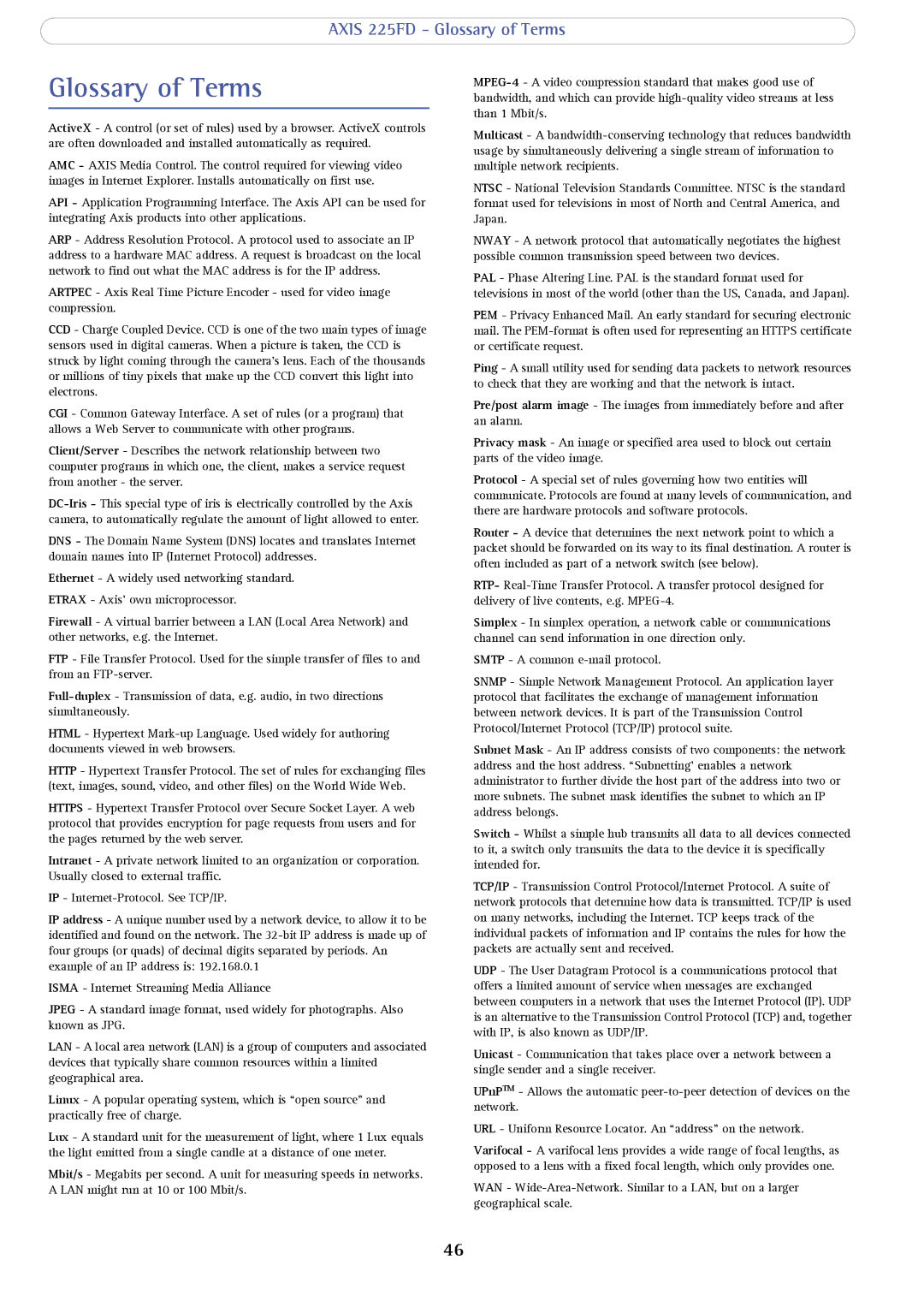
AXIS 225FD - Glossary of Terms
Glossary of Terms
ActiveX - A control (or set of rules) used by a browser. ActiveX controls are often downloaded and installed automatically as required.
AMC - AXIS Media Control. The control required for viewing video images in Internet Explorer. Installs automatically on first use.
API - Application Programming Interface. The Axis API can be used for integrating Axis products into other applications.
ARP - Address Resolution Protocol. A protocol used to associate an IP address to a hardware MAC address. A request is broadcast on the local network to find out what the MAC address is for the IP address.
ARTPEC - Axis Real Time Picture Encoder - used for video image compression.
CCD - Charge Coupled Device. CCD is one of the two main types of image sensors used in digital cameras. When a picture is taken, the CCD is struck by light coming through the camera’s lens. Each of the thousands or millions of tiny pixels that make up the CCD convert this light into electrons.
CGI - Common Gateway Interface. A set of rules (or a program) that allows a Web Server to communicate with other programs.
Client/Server - Describes the network relationship between two computer programs in which one, the client, makes a service request from another - the server.
DNS - The Domain Name System (DNS) locates and translates Internet domain names into IP (Internet Protocol) addresses.
Ethernet - A widely used networking standard. ETRAX - Axis' own microprocessor.
Firewall - A virtual barrier between a LAN (Local Area Network) and other networks, e.g. the Internet.
FTP - File Transfer Protocol. Used for the simple transfer of files to and from an
HTML - Hypertext
HTTP - Hypertext Transfer Protocol. The set of rules for exchanging files (text, images, sound, video, and other files) on the World Wide Web.
HTTPS - Hypertext Transfer Protocol over Secure Socket Layer. A web protocol that provides encryption for page requests from users and for the pages returned by the web server.
Intranet - A private network limited to an organization or corporation. Usually closed to external traffic.
IP -
IP address - A unique number used by a network device, to allow it to be identified and found on the network. The
ISMA - Internet Streaming Media Alliance
JPEG - A standard image format, used widely for photographs. Also known as JPG.
LAN - A local area network (LAN) is a group of computers and associated devices that typically share common resources within a limited geographical area.
Linux - A popular operating system, which is “open source” and practically free of charge.
Lux - A standard unit for the measurement of light, where 1 Lux equals the light emitted from a single candle at a distance of one meter.
Mbit/s - Megabits per second. A unit for measuring speeds in networks. A LAN might run at 10 or 100 Mbit/s.
Multicast - A
NTSC - National Television Standards Committee. NTSC is the standard format used for televisions in most of North and Central America, and Japan.
NWAY - A network protocol that automatically negotiates the highest possible common transmission speed between two devices.
PAL - Phase Altering Line. PAL is the standard format used for televisions in most of the world (other than the US, Canada, and Japan).
PEM - Privacy Enhanced Mail. An early standard for securing electronic mail. The
Ping - A small utility used for sending data packets to network resources to check that they are working and that the network is intact.
Pre/post alarm image - The images from immediately before and after an alarm.
Privacy mask - An image or specified area used to block out certain parts of the video image.
Protocol - A special set of rules governing how two entities will communicate. Protocols are found at many levels of communication, and there are hardware protocols and software protocols.
Router - A device that determines the next network point to which a packet should be forwarded on its way to its final destination. A router is often included as part of a network switch (see below).
RTP-
Simplex - In simplex operation, a network cable or communications channel can send information in one direction only.
SMTP - A common e-mail protocol.
SNMP - Simple Network Management Protocol. An application layer protocol that facilitates the exchange of management information between network devices. It is part of the Transmission Control Protocol/Internet Protocol (TCP/IP) protocol suite.
Subnet Mask - An IP address consists of two components: the network address and the host address. “Subnetting’ enables a network administrator to further divide the host part of the address into two or more subnets. The subnet mask identifies the subnet to which an IP address belongs.
Switch - Whilst a simple hub transmits all data to all devices connected to it, a switch only transmits the data to the device it is specifically intended for.
TCP/IP - Transmission Control Protocol/Internet Protocol. A suite of network protocols that determine how data is transmitted. TCP/IP is used on many networks, including the Internet. TCP keeps track of the individual packets of information and IP contains the rules for how the packets are actually sent and received.
UDP - The User Datagram Protocol is a communications protocol that offers a limited amount of service when messages are exchanged between computers in a network that uses the Internet Protocol (IP). UDP is an alternative to the Transmission Control Protocol (TCP) and, together with IP, is also known as UDP/IP.
Unicast - Communication that takes place over a network between a single sender and a single receiver.
UPnPTM - Allows the automatic
URL - Uniform Resource Locator. An “address" on the network.
Varifocal - A varifocal lens provides a wide range of focal lengths, as opposed to a lens with a fixed focal length, which only provides one.
WAN -
46
